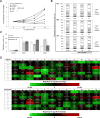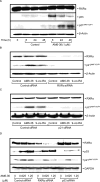Induction of retinoid X receptor activity and consequent upregulation of p21WAF1/CIP1 by indenoisoquinolines in MCF7 cells
- PMID: 21464033
- PMCID: PMC5554444
- DOI: 10.1158/1940-6207.CAPR-10-0004
Induction of retinoid X receptor activity and consequent upregulation of p21WAF1/CIP1 by indenoisoquinolines in MCF7 cells
Abstract
Retinoid X receptor (RXR) has been targeted for the chemoprevention and treatment of cancer. To discover potential agents acting through RXRs, we utilized an RXR response element (RXRE)-luciferase reporter gene assay. Following extensive screening, 3-amino-6-(3-aminopropyl)-5,6-dihydro-5,11-dioxo-11H-indeno[1,2-c]isoquinoline dihydrochloride (AM6-36) was found to induce RXRE-luciferase activities. AM6-36 inhibited COX-2 expression and anchorage-independent growth with 12-O-tetradecanoylphorbol 13-acetate-stimulated JB6 Cl41 cells, induced the expression of CD38 in HL-60 cells, and attenuated the growth of N-methyl-N-nitrosourea-induced mammary tumors in rats. Consistent with other reports describing the antiproliferative effects of RXR agonists in breast cancers, AM6-36 showed growth inhibition with cultured MCF7 breast cancer cells, accompanied by G(2)/M-phase arrest at lower concentrations and enhanced S-phase arrest at higher concentrations. On the basis of DNA microarray analysis, AM6-36 upregulated the expression of CDKN1A, a target gene of RXR, by 35-fold. In accord with this response, the expression of the corresponding protein, p21(WAF1/CIP1), was increased in the presence of AM6-36. Induction of p21 by AM6-36 was abrogated following transient knockdown of RXRα, demonstrating that the effect of AM6-36 on the expression of p21 is closely related to modulation of RXRα transcriptional activity. Intestinal permeability was suggested with Caco-2 cells and limited metabolism resulted when AM6-36 was incubated with human liver microsomes. Oral administration with rats resulted in 0.8 μg/mL, 4.3 μg/g, and 0.3 μg/g in serum, liver, and mammary gland, respectively. In sum, these data suggest that AM6-36 is a promising lead for the treatment or prevention of breast cancer and provide a strong rationale for testing in more advanced antitumor systems.
©2011 AACR.
Figures






Similar articles
-
Induction of apoptosis by 3-amino-6-(3-aminopropyl)-5,6-dihydro-5,11-dioxo-11H-indeno[1,2-c]isoquinoline via modulation of MAPKs (p38 and c-Jun N-terminal kinase) and c-Myc in HL-60 human leukemia cells.J Nat Prod. 2012 Mar 23;75(3):378-84. doi: 10.1021/np200791j. Epub 2011 Dec 7. J Nat Prod. 2012. PMID: 22148260 Free PMC article.
-
Identification, synthesis, and biological evaluation of the metabolites of 3-amino-6-(3'-aminopropyl)-5H-indeno[1,2-c]isoquinoline-5,11-(6H)dione (AM6-36), a promising rexinoid lead compound for the development of cancer chemotherapeutic and chemopreventive agents.J Med Chem. 2012 Jun 28;55(12):5965-81. doi: 10.1021/jm3006806. Epub 2012 Jun 19. J Med Chem. 2012. PMID: 22712432 Free PMC article.
-
Acyclic retinoid activates retinoic acid receptor beta and induces transcriptional activation of p21(CIP1) in HepG2 human hepatoma cells.Mol Cancer Ther. 2004 Mar;3(3):309-16. Mol Cancer Ther. 2004. PMID: 15026551
-
Inhibition of MDA-MB-231 breast cancer cell proliferation and tumor growth by apigenin through induction of G2/M arrest and histone H3 acetylation-mediated p21WAF1/CIP1 expression.Environ Toxicol. 2017 Feb;32(2):434-444. doi: 10.1002/tox.22247. Epub 2016 Feb 12. Environ Toxicol. 2017. PMID: 26872304
-
p21WAF1/CIP1 is a common transcriptional target of retinoid receptors: pleiotropic regulatory mechanism through retinoic acid receptor (RAR)/retinoid X receptor (RXR) heterodimer and RXR/RXR homodimer.J Biol Chem. 2007 Oct 12;282(41):29987-97. doi: 10.1074/jbc.M701700200. Epub 2007 Jul 26. J Biol Chem. 2007. PMID: 17656367
Cited by
-
Evidence supporting the conceptual framework of cancer chemoprevention in canines.Sci Rep. 2016 May 24;6:26500. doi: 10.1038/srep26500. Sci Rep. 2016. PMID: 27216246 Free PMC article.
-
Fraxinus xanthoxyloides leaves reduced the level of inflammatory mediators during in vitro and in vivo studies.BMC Complement Altern Med. 2016 Jul 19;16:230. doi: 10.1186/s12906-016-1189-7. BMC Complement Altern Med. 2016. PMID: 27430329 Free PMC article.
-
Synthesis and biological evaluation of (3/4-(pyrimidin-2-ylamino)benzoyl)-based hydrazine-1-carboxamide/carbothioamide derivatives as novel RXRα antagonists.J Enzyme Inhib Med Chem. 2020 Dec;35(1):880-896. doi: 10.1080/14756366.2020.1740692. J Enzyme Inhib Med Chem. 2020. PMID: 32223461 Free PMC article.
-
Skeletal muscle PGC-1α controls whole-body lactate homeostasis through estrogen-related receptor α-dependent activation of LDH B and repression of LDH A.Proc Natl Acad Sci U S A. 2013 May 21;110(21):8738-43. doi: 10.1073/pnas.1212976110. Epub 2013 May 6. Proc Natl Acad Sci U S A. 2013. PMID: 23650363 Free PMC article.
-
Synthesis and Biological Activity of a New Indenoisoquinoline Copper Derivative as a Topoisomerase I Inhibitor.Int J Mol Sci. 2023 Sep 26;24(19):14590. doi: 10.3390/ijms241914590. Int J Mol Sci. 2023. PMID: 37834037 Free PMC article.
References
-
- Mangelsdorf DJ, Ong ES, Dyck JA, Evans RM. Nuclear receptor that identifies a novel retinoic acid response pathway. Nature. 1990;345:224–9. - PubMed
-
- Szanto A, Narkar V, Shen Q, Uray IP, Davies PJ, Nagy L. Retinoid X receptors: X-ploring their (patho)physiological functions. Cell Death Differ. 2004;11:S126–43. - PubMed
-
- Mangelsdorf DJ, Evans RM. The RXR heterodimers and orphan receptors. Cell. 1995;83:841–50. - PubMed
-
- Wolf G. Is 9-cis-retinoic acid the endogenous ligand for the retinoic acid-X receptor? Nutr Rev. 2006;64:532–8. - PubMed
-
- Germain P, Chambon P, Eichele G, et al. International Union of Pharmacology. LXIII. Retinoid X receptors. Pharmacol Rev. 2006;58:760–72. - PubMed
Publication types
MeSH terms
Substances
Grants and funding
LinkOut - more resources
Full Text Sources
Other Literature Sources
Research Materials

